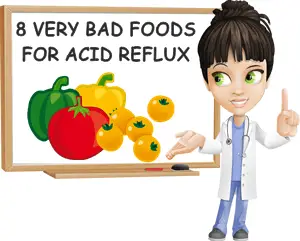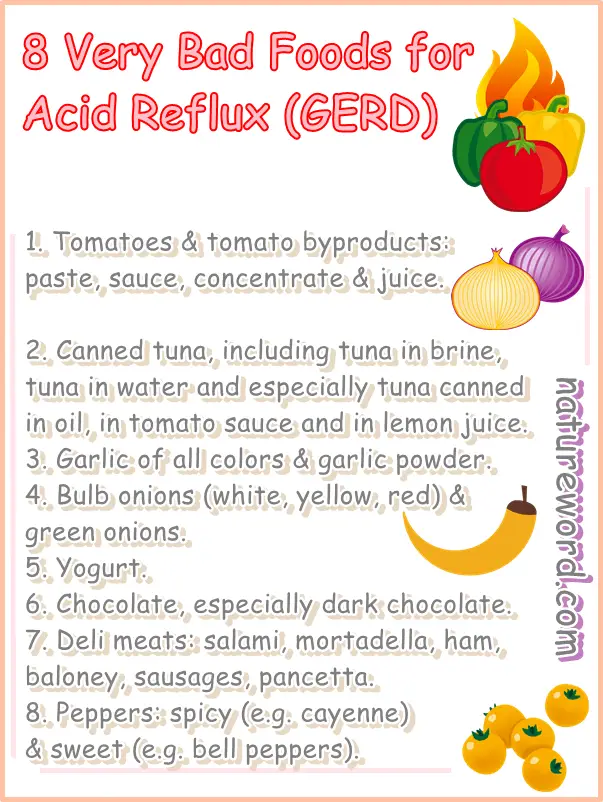Foods that are very bad for acid reflux typically include foods that trigger the relaxation of the lower esophageal sphincter (LES), leading to the backflow of stomach acids into the esophagus. Acid reflux, also known as gastroesophageal reflux disease (GERD), is a condition where stomach acid frequently flows back into the tube connecting the mouth and stomach, causing irritation. The relationship between certain foods and acid reflux is critical because these foods can exacerbate the symptoms of acid reflux by increasing stomach acidity or by relaxing the LES.
Fatty foods are highly problematic for individuals with acid reflux. These foods slow down the process of emptying the stomach, thereby increasing the risk of acid backflow. Similarly, spicy foods can irritate the esophagus, which is already sensitive due to the acid reflux condition. Spicy foods contribute to the discomfort and pain associated with acid reflux by causing further irritation to the lining of the esophagus.
Citrus fruits, rich in acidity, can exacerbate symptoms by increasing the acidity in the stomach. This heightened level of acidity can lead to more severe symptoms for those suffering from acid reflux. Chocolate is another food that is bad for acid reflux because it contains methylxanthine, a compound that has been shown to relax the LES and allow stomach acids to enter the esophagus more easily.
Caffeinated beverages, such as coffee and tea, can lead to the relaxation of the LES, which increases the likelihood of acid reflux episodes. These beverages can trigger the symptoms of acid reflux by relaxing the LES, thereby allowing acid to escape from the stomach into the esophagus. Alcohol has a similar effect on the LES, weakening it and making it easier for stomach acids to backflow into the esophagus, which can aggravate acid reflux symptoms.
Tomatoes and tomato-based products, which are inherently acidic, can increase stomach acidity and trigger acid reflux symptoms. These foods can cause discomfort to individuals with acid reflux by increasing the acid content in the stomach, leading to more intense symptoms. Garlic and onions, although healthy in many respects, can exacerbate acid reflux symptoms in some individuals by irritating the esophagus or relaxing the LES.
If you have been experiencing flareups in your condition with symptoms such as heartburn, excessive burping that is acidic or sour, nausea and stomach acidity, then chances are you’ve been eating the wrong foods all along. If you too have acid reflux and have been struggling with what to eat, then it might be worth your while to take a look at the foods listed below.
Understanding what to eat and what not to eat for acid reflux treatment can prove daunting as so many otherwise extremely healthy foods, full of benefits for health, are bad for acid reflux. Even worse, they are pushed on acid reflux sufferers by those with no first-hand experience with the condition. Eating for acid reflux specifically is different from conventional healthy eating and this is where the struggle lies.

If you’ve been struggling to get rid of acid reflux but just couldn’t figure out what you were doing wrong in terms of diet, then it might be worth your while to take a look at my list below of 8 very common foods that are very bad for acid reflux.
In case you’ve been eating any of them more than occasionally and in very small amounts, then that’s where you’ve likely sabotaged your diet and recovery.
8 Foods that are Very Bad for Acid Reflux
1- Tomatoes and tomato byproducts
According to the UN Food and Agriculture Organization, over 186 million tonnes or 186 000 kilograms of tomatoes were produced worldwide in 2021. And the numbers aren’t taking into account tomato yield from home gardeners that grow the botanical fruit for personal consumption (households can easily grow up to 1000 kilograms of tomatoes per season to make tomato sauce, for example).
It’s safe to say that people like to eat tomatoes. But tomatoes top the list of foods that are bad to eat with acid reflux because they are acidic. Still, people with the condition continue to eat them as they’ve become a staple across cuisines. If you have acid reflux and want to get rid of it for good, tomatoes are one of the first foods to exclude from your diet. It’s even more urgent to exclude tomato byproducts from your diet, namely tomato paste and concentrate and tomato sauce, but also tomato juice. Also find out who else shouldn’t drink tomato juice.
Naturally, not everyone who eat tomatoes will get acid reflux and not everyone with GERD will experience the same degree of digestive upset after eating tomatoes, but tomatoes remain one of the worse foods for acid reflux.
Both commercial and home made tomato byproducts are bad for acid reflux, irrespective of how natural and clean they are. Of course, preservatives and all sorts of additives, additional ingredients such as garlic, onions and peppers also trigger flareups, but that doesn’t make tomatoes any less bad for the condition.

2- Canned tuna
Did you know canned tuna is very bad for acid reflux? So many people with GERD are not made aware of the very real fact that canned tuna causes severe stomach acidity and really bad acid reflux, including acid reflux at night.
Eating canned tuna can cause digestive upset that lasts for days at a time in someone with active acid reflux disease. Tuna is actually worse than most other canned fish, even when canned in water or brine. Ideally, if you must have canned tuna with acid reflux, choose tuna canned in water or brine, not oil, have it at lunch, not dinner, and always make sure you stand or are up and about for 4 hours or so after eating it. Just as important, have it infrequently if you have GERD.
If you don’t have acid reflux disease, canned tuna is actually one of the healthiest foods you can eat. Tuna is a nutritionally dense food which means it provides excellent nutrition, contributing measurably to daily nutritional requirements. In fact, tuna is one of the few foods that naturally have vitamin D, and has a high content of it – find out how much vitamin D in tuna. Also see what are the top nutrition facts of tuna.
Eating tuna is good for the immune system, supports thyroid metabolism and boosts fertility and pregnancy rates, to name just a few its wonderful benefits for health. Discover more benefits of eating tuna.
3- Garlic
Garlic is a favorite seasoning that’s trumped only by onions, but not always. In addition to its winning flavor, it’s also extremely healthy.
For example, the flavor compounds in garlic are known for their anticancer properties and studies recognize garlic as having natural antibiotic properties.Vs regular garlic, red garlic is also a source of pigmented anthocyanin constituents, antioxidants with scientifically proven anticancer activities.
Even black garlic, which is essentially a garlic cooked beyond recognition, is extremely healthy. Black garlic has four to five times more antioxidants compared to fresh, according to research. All that considered, garlic is one of the worst foods you can eat for acid reflux. The same constituents responsible for its popular flavor and health benefits are what make it bad for acid reflux.
If you have GERD, then it’s best to avoid garlic altogether, including fresh, cooked and powdered. And whatever you do, never have garlic on an empty stomach.
4- Onion
Onion is just as popular as garlic and just as healthy. Whatever onion color you choose, whether it’s white bulb onions or green spring onions, the more mellow tasting yellow onion or the colorful and healthy red onion, you will enjoy a range of benefits for health.
But if you have acid reflux, then the side effects you will experience as a result of eating onions will trump the benefits. While you’ll definitely miss the flavor, onion is best avoided if you want to get rid of acid reflux, at least while you’re on the diet.
5- Chocolate, especially dark chocolate
Between coffee and chocolate, chocolate is often times worse for acid reflux. And everyone eats chocolate.
But if you have acid reflux and are struggling to manage it, then chocolate is definitely something you’ll want to cut out of your diet. Dark chocolate, which is indeed the healthiest of all types of chocolate, causes the most side effects for acid reflux.
What makes chocolate really bad for acid reflux is actually biologically active constituents in cocoa such as caffeine and theobromine. These constituents act as irritants and work up the stomach triggering the production of excess gastric acid. This favors regurgitation and exacerbates GERD symptoms.
As they escape from the stomach gastric juices irritate the sensitive mucous lining of the esophagus and cause inflammation and symptoms such as heartburn which is a strong burning sensation in the chest. Profuse sweating, nausea, feeling sick to the stomach, palpitations and other side effects may also occur, depending on how severe the acid reflux is.
6- Yogurt
Did you know that yogurt is a food that is really bad for acid reflux? Yogurt, both natural Greek yogurt and yogurt with fruit, is not a universally healthy food. People with acid reflux, especially if it’s poorly managed, have a hard time eating yogurt without experiencing stomach upset.
Whether it’s perceivably acidic, or fermented but without actually tasting sour, yogurt has a natural makeup that drives side effects for GERD. It’s common to experience regurgitation after eating yogurt, especially plain yogurt, and a burning sensation in the throat or sour taste in the mouth.
So if you’ve been eating yogurt because it’s healthy and thought it would be a safe food to have with acid reflux, or even good for it, but have been experiencing side effects, then know that it’s actually a common trigger for acid reflux and can easily cause moderate to severe digestive upset.
7- Deli meats (cold cuts, cold meats)
What makes deli meats so popular is both the fact that they taste good, but more so the fact that they pack extremely well. However, most deli meats are very bad for acid reflux and often trigger flareups in the condition. For some deli meats it’s the preservatives that cause digestive upset (e.g. salami such as pepperoni or summer sausage, smoked pork and ham).
For others it’s the high fat content that upsets the stomach and goes on to trigger indigestion and regurgitation of stomach contents (e.g. mortadella, bologna, baloney or polony, parizer or Parisian sausage, Italian cotechino, hams such as Romanian șuncă or traditional Italian pancetta and most pork belly preparations such as bacon).
And for some it’s the spices in addition to other problematic ingredients (e.g. most sausages have garlic, onion, paprika or pepper powder, peppercorns, ginger etc., pork jelly also typically has lots of garlic).
8- Peppers, sweet and spicy
If you’ve been eating peppers, whether spicy peppers or sweet bell peppers, or pepper powder (paprika), then that’s what’s likely making your acid reflux worse.
What makes spicy peppers like cayenne and sweet peppers like bell peppers bad for acid reflux are pungent and non-pungent capsaicinoid constituents which irritate the stomach lining causing the production of excess stomach acid.
An excess of stomach acid creates pressure on the gastroesophageal reflux sphincter that closes off the stomach and pushes it open causing the highly acidic stomach acid to escape and rise up into the esophagus which is the very definition of GERD.
Both pungent and non-pungent capsaicinoids are natural compounds that give peppers their particular flavor and a great deal of their benefits for health. They’re just not good for everyone, especially for those with acid reflux.
